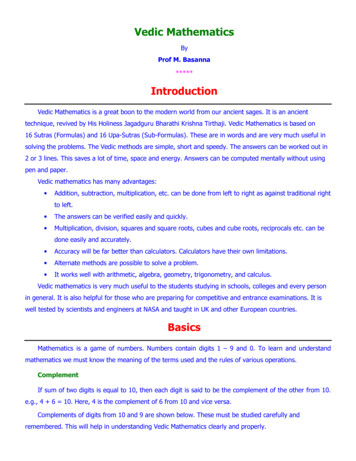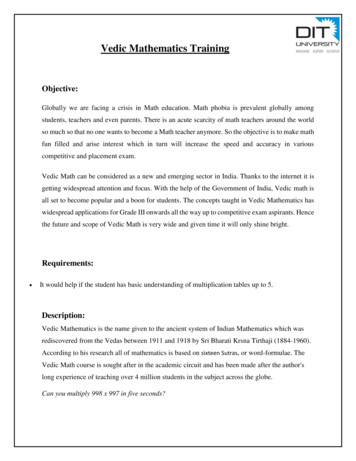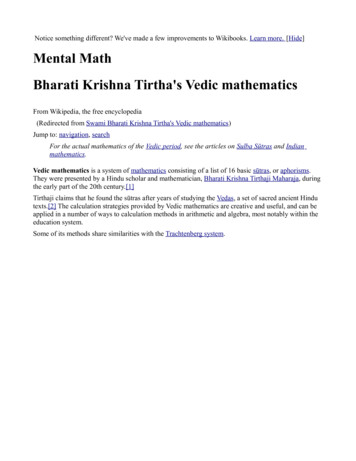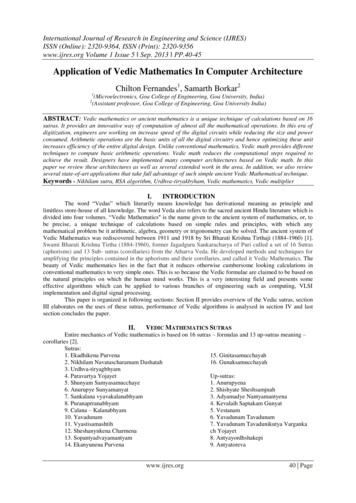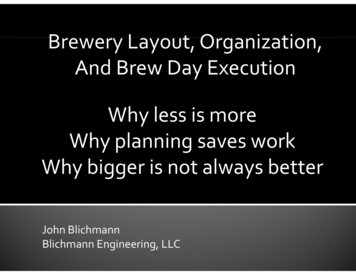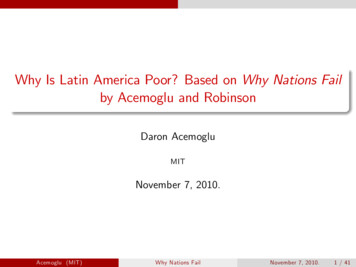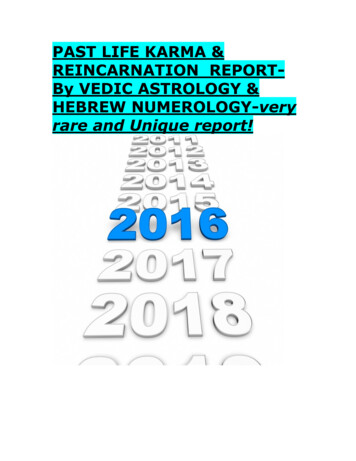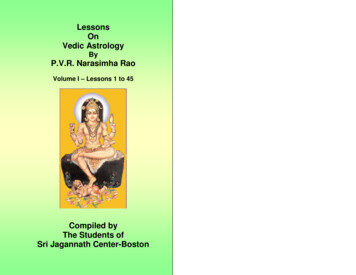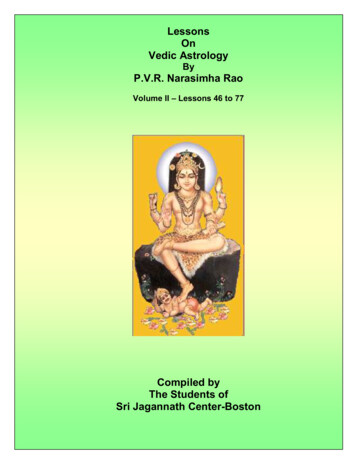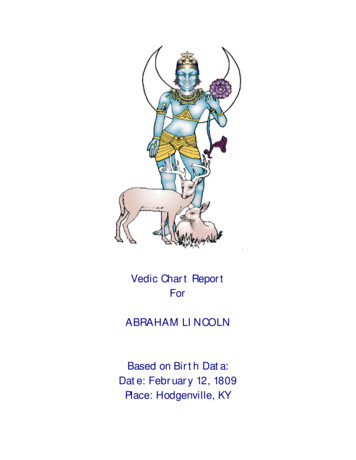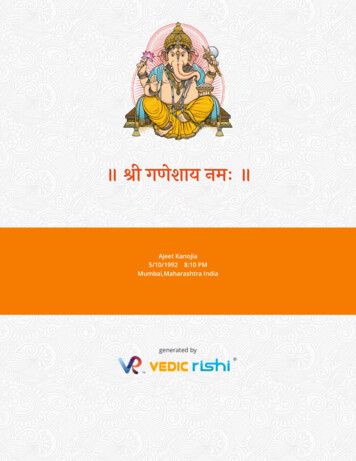
Transcription
Why Vedic Mathematics?Many Indian Secondary School students consider Mathematics a very difficultsubject. Some students encounter difficulty with basic arithmeticaloperations. Some students feel it difficult to manipulate symbols and balanceequations. In other words, abstract and logical reasoning is their hurdle.Many such difficulties in learning Mathematics enter into a long list ifprepared by an experienced teacher of Mathematics. Volumes have beenwritten on the diagnosis of 'learning difficulties' related to Mathematics andremedial techniques. Learning Mathematics is an unpleasant experience tosome students mainly because it involves mental exercise. To reduce allthese hurdles and make the learning process of mathematics enjoyable,Vedic mathematics is needed.Squares of numbers ending in 5:Consider the example 252 .Here the number is 25. We have to find out the square of the number.For the number 25, the last digit is 5 and the 'previous' digit is 2. Hence,'one more than the previous one', that is, 2 1 3. The Sutra, in thiscontext, gives the procedure ‘to multiply the previous digit 2 by onemore than itself, that is, by 3'.It becomes the L.H.S (left hand side) of the result, that is, 2 X 3 6.The R.H.S (right hand side) of the result is52, that is, 25.Thus 252 2 X 3 / 25 625.In the same way,352 3 X (3 1) /25 3 X 4/ 25 1225;652 6 X 7 / 25 4225;Square a numberRules:Rule 1 : Find the base of given number. That is maybe, 10, 100, 1000,10000, .Rule 2 : Find the difference between base and a given number. That isa deficiency value.Rule 3 : Subtract the given number by deficiency and then multiply bybase.Rule 4 : Square the deficiency value.Rule 5 : Add rule 3 result with the rule 4 result. Its a final result.
Example: 93 X 93Rule1:Rule2:Rule 3 : (93 - 7)Rule4:Rule5: 93 X 93 864993base10093X 100 86 X7X78600 49is 100 10078600498649MultiplicationMultiplication of two 2 digit numbers.numbers.Vedic Mathematics offers various ways of multiplication two numbers.1 MethodFind the product 14 X 12i) The right hand most digit of the multiplicand, the first number (14)i.e.,4 is multiplied by the right hand most digit of the multiplier, thesecond number (12) i.e., 2. The product 4 X 2 8 forms the right handmost part of the answer.ii) Now, diagonally multiply the first digit of the multiplicand (14) i.e., 4and second digit of the multiplier (12)i.e., 1 (answer 4 X 1 4); thenmultiply the second digit of the multiplicand i.e.,1 and first digit of themultiplier i.e., 2(answer 1 X 2 2); add these two i.e.,4 2 6. Itgives the next, i.e., second digit of the answer. Hence second digit ofthe answer is 6.iii) Now, multiply the second digit of the multiplicand i.e., 1 and seconddigit of the multiplier i.e., 1 vertically, i.e., 1 X 1 1. It gives the lefthand most part of the answer.Thus the answer is 16 8.Symbolically we can represent the process as follows :The symbols are operated from right to left .
Step i)Step ii)Step iii)Now in the same process, answer can be written �2 : 6 3 : 9 299 (Recall the 3 steps)Method 2This method is used specifically to multiply numbers in which anynumber is multiplied by 9,99,999.Rules1) Write one less than the multiplicand.2) Write the deficiency of multiplicand.Multiply 58 by 9958 x 99 (58-1)(100-58) 57 574242
Method 3The formula can be very effectively applied in multiplication of numbers,which are nearer to bases like 10, 100, 1000i.e., to the powers of 10 .The numbers taken can be either less or more than the base considered.The difference between the number and the base is termed asdeviation.Deviation may be positive or negative. Positive deviation is writtenwithout the positive sign and the negative deviation, is written using anegative sign.Now observe the following table.Number14897112993Base10101001001000Number – Base14 – 108 - 1097 – 100112 – 100993 – 1000Deviation4-2-0312-007The general form of the multiplication under can be shown as follows :Let N1 and N2 be two numbers near to a given base in powers of 10,andD1 and D2 are their respective deviations from the base. Then N1 XN2 can be represented asCase (i) Both the numbers are lower than the base.Ex. 1: Find 97 X 94. Here base is 100. Now following the rules, theworking is as follows:97 x 94 9118.Ex. 2: 98 X 97 Base is 100.
98 x 97 9506Ex. 3: 994X988. Base is 1000.Make sure that no. Of digits in the multiplication of the deviations isequal to the no. Zeroes in the base.Case ( ii) : Both the numbers are higher than the base.The method and rules follow as they are. The only difference is thepositive deviation. Instead of cross – subtract, we follow cross – add.Ex. 4: 13X12. Base is 10Case ( iii ): One number is more and the other is less than the base.In this situation one deviation is positive and the other is negative. Sothe product of deviations becomes negative. So the right hand side ofthe answer obtained will therefore have to be subtracted. To have aclear representation and understanding a vinculum is used. It proceedsinto normalization.Ex.11: 13X7. Base is 1013307-3103 (-3) -9As the base is 10 . So, 10-9 1
So , 13 x 7 91Ex. 5: 108 X 94. Base is 100.Ex. 6: 998 X 1025. Base is 1000.Method 4 ::- Visual multiplication with LinesHere's a way to multiply numbers visually!Suppose you want to multiply 22 by 13. Draw 2 lines slanted upward tothe right, and then move downward to the right a short distance anddraw another 2 lines upward to the right (see the magenta lines inFigure 1). Then draw 1 line slanted downward to the right, and thenmove upward to the right a short distance and draw another 3 linesslanted downward to the right (the cyan lines in Figure 1).Now count up the number of intersection points in each corner of thefigure. The number of intersection points at left (green-shaded region)will be the first digit of the answer. Sum the number of intersectionpoints at the top and bottom of the square (in the blue-shaded region);this will be the middle digit of the answer. The number of intersectionpoints at right (in the yellow-shaded region) will be the last digit of theanswer.
This will work to multiply any two two-digit numbers, but if any of thegreen, blue, gold sums have 10 or more points in them, be sure to carrythe tens digit to the left, just as you would if you were adding.The Math Behind the Fact:The method works because the number of lines are like placeholders (atpowers of 10: 1, 10, 100, etc.), and the number of dots at eachintersection is a product of the number of lines. You are then summingup all the products that are coefficients of the same power of 10. Thusthe in the example22 x 13 ( 2*10 2 ) * ( 1*10 3 ) 2*1*100 2*3*10 2*1*10 2*3 286.The diagram displays this multiplication visually. In the green-shadedregion there are 2*1 2 dots. In the blue-shaded region there are2*3 2*1 8 dots. In the gold-shaded region there are 2*3 6 dots. Thismethod does exactly what you would do if you wrote out themultiplication the long way and added the columns!The method can be generalized to products of three-digit numbers (ormore) using more sets of lines (and summing the dot groupingsvertically and remembering to carry when needed). It can also begeneralized to products of three-numbers using cubes of lines ratherthan squares! (Of course, it gets pretty unwieldy to use the method atthat point.)METHOD 5 :To multiply three digit numbers
Consider the following example124 X 132.Proceeding from right to lefti)4 X 2 8. First digit 8ii)(2 X 2) (3 X 4) 4 12 16. The digit 6 is retained and 1 iscarried over to left side. Second digit 6.iii)(1 X 2) (2 X 3) (1 X 4) 2 6 4 12. The carried over1 of above step is added i.e., 12 1 13. Now 3 is retainedand 1 is carried over to left side. Thus third digit 3iv)( 1X 3 ) ( 2 X 1 ) 3 2 5. the carried over 1 of abovestep is added i.e., 5 1 6 . It is retained. Thus fourth digit 6.v) ( 1 X 1 ) 1. As there is no carried over number from theprevious step it is retained. Thus fifth digit 1124 X 132 16368.Let us work another problem by placing the carried over digits under thefirst row and proceed.234x �‾73944i)4 X 6 24 : 2, the carried over digit is placed below the seconddigit.ii) (3 X 6) (4 x 1) 18 4 22 ; 2, the carried over digit is placedbelow third digit.(iii)(2 X 6) (3 X 1) (4 X 3) 12 3 12 27 ; 2, thecarried over digit is placed below fourth digit.iv) (2 X 1) ( 3 X 3) 2 9 11; 1, the carried over digit is placedbelow fifth digit.v) ( 2 X 3 ) 6.vi) Respective digits are added.
METHOD 6 :To find the square of any number irrespective of its deficiency. I t isspecifically useful for finding squares of number nearer to 10,100,1000etc.Rule 1:- Find the deficiency of the number.Rule 2 :- The right hand side of the answer is the square of deficiency.Rule 3 :- To find the left side of the answer subtract the deficiency fromthe number.Ex.1. (96)2100-96 4(4)2 1696-4 92So, (96)2 9216(114)2100-114 -14(-14)2 196 (3 digits)Here the right part has three digits, one more than the no.Zeroes in the working base, so 1 is carry over.114-(-14) 1 128 1 1292So, (114) 12996Ex.2.Ex.3 (9991)2Working base of 9991 is 10000Deficiency 10000-9991 092(09) 81As the working base contains 4 zeroes , so right hand side of theanswer is 0081.Now , 9991-9 9982So , (9991)2 99820081.
2.CUBINGTake a two digit number say 14.i) Find the ratio of the two digits i.e. 1:4ii) Now write the cube of the first digit of the number i.e. 13iii) Now write numbers in a row of 4 terms in such a way that the firstone is the cube of the first digit and remaining three are obtained in ageometric progression with common ratio as the ratio of the original twodigits (i.e. 1:4) i.e. the row is141664.iv) Write twice the values of 2nd and 3rd terms under the termsrespectively in second row.i.e.,141683264( 2 x 4 8, 2 x 16 32)v) Add the numbers column wise and follow carry over process.141664Since 16 32 6 (carryover) 54Now2832744 written and 5 (carryover) 4 8 1747 written and 1 (carryover) 1 2.This 2744 is nothing but the cube of the number 14
Example 2: Find 333Find the cubes of the following numbers using Vedic sutras.103, 112, 91, 89, 998, 9992, 1014.
To divide the numbers by 9Consider some two digit numbers (dividends) and same divisor 9.Observe the following example.i) 13 9 The quotient (Q) is 1, Remainder (R) is 4.Since9 ) 13 ( 194ii)34 9, Q is 3, R is 7.iii)60 9, Q is 6, R is 6.iv)80 9, Q is 8, R is 8.Now we have another type of representation for the above examples asgiven here under:i) Split each dividend into a left hand part for the Quotient and right hand part for the remainder by a slant line or slash.Eg.13 as 1 / 3,34 as 3 / 4 ,80 as 8 / 0.ii) Leave some space below such representation, draw a horizontal line.Eg.1/33/4,8/0,iii) Put the first digit of the dividend as it is under the horizontal line. Putthe same digit under the right hand part for the remainder, add the twoand place the sum i.e., sums of the digits of the numbers as theremainder.Eg.1/313/438/08
1 / 4Now the problem is over. i.e.,3 / 78 / 813 9 gives Q 1, R 434 9 gives Q 3, R 780 9 gives Q 8, R 8Proceeding for some more of the two digit number division by 9, we geti.e.a) 21 9 asQ 2, R 39)2 /122/3i.e.b) 43 9 asQ 4, R 7.9) 4 / 344/7The examples given so far convey that in the division of two digitnumbers by 9, we can mechanically take the first digit down for thequotient – column and that, by adding the quotient to the second digit,we can get the remainder.Now in the case of 3 digit numbers, let us proceed as follows.i)ii)9 ) 104 ( 119 ) 212 ( 239)10 / 4991/1511 / 59)21 / 22072/3523 / 5Note that the remainder is the sum of the digits of the dividend. Thefirst digit of the dividend from left is added mechanically to the second
digit of the dividend to obtain the second digit of the quotient. This digitadded to the third digit sets the remainder. The first digit of the dividendremains as the first digit of the quotient.Consider511 9Add the first digit 5 to second digit 1 getting 5 1 6. Hence Quotientis 56. Now second digit of 56 i.e., 6 is added to third digit 1 of dividendto get the remainder i.e., 1 6 7Thus9)51 / 15/ 656 / 7Q is 56, R is 7.Extending the same principle even to bigger numbers of still more digits,we can get the results.Eg : 1204 9i) Add first digit 1 to the second digit 2. 1 2 3ii) Add the second digit of quotient 13. i.e., 3 to third digit ‘0’ and obtainthe Quotient. 3 0 3, 133iii) Add the third digit of Quotient 133 i.e.,3 to last digit ‘4’ of thedividend and write the final Quotient and Remainder. R 3 4 7, Q 133In symbolic form9 ) 120 / 413 / 3133 / 7Another example.gives9 ) 132101467 / 714677 / 8/ 1132101 9Q 14677, R 8
In all the cases mentioned above, the remainder is less than the divisor.What about the case when the remainder is equal or greater than thedivisor?Eg.9) 3 / 69) 24 / 632/63 / 9 (equal)26 / 12 (greater)We proceed by re-dividing the remainder by 9, carrying over thisQuotient to the quotient side and retaining the final remainder in theremainder side.9) 3 / 69 ) 24 / 6/32/63/926 / 124/0Q 4,27 / 3R 0Q 27,R 3.When the remainder is greater than divisor, it can also be representedas9 ) 24 / 62 / 626 / 1 / 2/11 /327 / 3
Fast Maths Tricks and ShortcutsSquaringIn this simple trick we need to modify the equation and make the units digit zero.After all it is easy to multiply when units digit is zero.For example - Find square of 43 (43 3) (43-3) (3 3) (46 40) 9 (460 4) 9 1840 9 1849SquaringIn this simple trick we need to modify the equation and make the units digit zero.After all it is easy to multiply when units digit is zero.For example - Find square of 43 (43 3) (43-3) (3 3) (46 40) 9 (460 4) 9
Vedic mathematics is needed. Squares of numbers ending in 5:Squares of numbers ending in 55::5: Consider the example 252. Here the number is 25. We have to find out the square of the number. For the number 25, the last digit is 5 and the 'previous' digit is 2. Hence, 'one more than the previous one', that is, 2 1 3. The Sutra, in this

